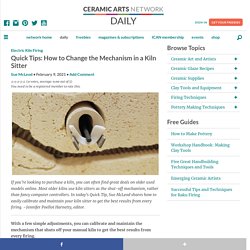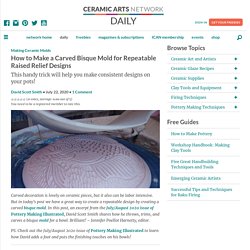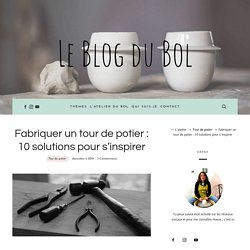

Quick Tips: How to Change the Mechanism in a Kiln Sitter. If you’re looking to purchase a kiln, you can often find great deals on older used models online.

Most older kilns use kiln sitters as the shut-off mechanism, rather than fancy computer controllers. In today’s Quick Tip, Sue McLeod shares how to easily calibrate and maintain your kiln sitter to get the best results from every firing. –Jennifer Poellot Harnetty, editor. With a few simple adjustments, you can calibrate and maintain the mechanism that shuts off your manual kiln to get the best results from every firing. Manual kilns have switches for turning up the heat and they have a nifty contraption called a kiln sitter that uses a melting, bending pyrometric cone to shut the kiln off at a specific temperature. Learn to get the most out of electric kilns when you download this freebie, Techniques and Tips for Electric Kilns. As the kiln approaches its target temperature, the cone in the kiln sitter will soften and the weight of the sensing rod will cause the cone to bend (2). How to Wedge Clay Properly. How to Make a Dorodango (Japanese Polished Clay Ball)
Kurinuki Pots. Pit-firing Pottery With Chris Dunn. Primitive Style Pottery Firing in a Steel Barrel. Pit Fire Pottery In Your Backyard. MAKING A SIMPLE CERAMIC CUP. MAKING A SIMPLE CERAMIC CUP. Ceraselle - Réalisation d'un collier en céramique émaillée. Sketch & Stretch with Chandra DeBuse - Ceramic Arts Network. In this installment of the Ceramic Arts Daily Video Series, Chandra DeBuse shares her techniques for constructing and decorating playful pottery.

Using molds and templates made from bisqued clay, wood, and craft foam, Chandra demonstrates three unique forms based on sketched shapes: a scoop, nesting dishes, and a thrown and altered yunomi. Chandra shows how to take advantage of the clay’s malleability, contrasting pillowy volume with the beautiful lines created by the molds and templates.
She also shares her surfacing and glazing techniques for creating colorful, illustrated pieces, demonstrating inlaid lines with underglaze, as well as sgraffito and brushwork. Plus, she shows how you can combine all three using wax resist. By the conclusion, you will have picked up skills and ideas for creating personal pottery forms with colorful, layered surfaces. See this video in our shop. How to Make a Carved Bisque Mold for Repeatable Raised Relief Designs - Ceramic Arts Network. Carved decoration is lovely on ceramic pieces, but it also can be labor intensive.

But in today’s post we have a great way to create a repeatable design by creating a carved bisque mold. In this post, an excerpt from the July/August 2020 issue of Pottery Making Illustrated, David Scott Smith shares how he throws, trims, and carves a bisque mold for a bowl. Brilliant! – Jennifer Poellot Harnetty, editor. PS. Several years ago, I discovered an exciting way to create bowls with raised relief designs by using bisque-fired bowl molds on the pottery wheel.
Creating the Carved Bisque Mold Begin by throwing a bowl on the wheel. Consider the pitch when making the bowl. After the bowl has been thrown on the wheel, attach a handle or knob inside the bowl on the bottom to help in releasing finished forms later on. 1 Use wads to secure the leather-hard bowl to the bat before trimming into a dome. 2 Carving tools including an X-Acto knife, bent needle tool, and ribbon tools.
Sans titre. Bottle Slumping a Recycled Glass Cheese Tray. Fabriquer un tour de potier: 10 solutions pour s'inspirer – Le Blog du Bol. Le prix des tours de potier vous exaspère et vous avez quelques compétences en bricolage ?

💡 Fabriquer un tour de potier est une idée qui germe dans bon nombre de cerveau d’amateurs de poterie. Il vous faudra plus ou moins de matériel et pas mal d’huile de coude. Cone 10 Reduction 40.90 Nepheline Syenite 9.80 Kona F- 4 Feldspar 18.20 EPK Kaolin 13.20 Kentucky Ball Clay 17.30 Soda Ash Add: 6.0 % Red Art (Optional )

Sans titre. Photo Lithography on Clay: A Surprisingly Simple Way to Print Images On Clay - Ceramic Arts Network. A couple of years ago, I had the pleasure of watching Kristina Bogdanov demonstrate a really cool way to transfer photographic images onto clay surfaces.

And, don’t worry! We captured the whole thing on video to share with you, my faithful readers! Though the name sounds a bit intimidating, photo lithography image transfer onto clay, is not a terribly difficult process. You just need to get a couple of tools that you might not have on hand, but once you do that, it’s a piece of cake. In this video, Kristina shows us how. – Jennifer Poellot Harnetty, editor. Learn how to use ceramic colorants, stains, and underglazes when you download this freebie, How to Add Color to Your Ceramic Art. For best finished results, Kristina suggests using darker Mason Stains, such as: Royal Blue 6339 Deep Brown 6109 or 6190 Black 6657 or 6666 Some oxides can also work, although Mason Stains are the most reliable for strong color.
(136) Cottura ceramica in fossa-parte 2°.mov. (136) Cottura ceramica in fossa-parte 1°.mov. Sans titre. Comment réaliser vous-même un carreau en céramique? Sans titre. Sans titre. YouTube. 3 Great Brush Tips for Majolica Decoration. Bottle Slumping a Recycled Glass Cheese Tray. Glazing with Eggshells + Oil Spot and Rivulet Recipes Cone 5/6. Copper Wire Glaze Test - Cone 5/6 Electric Kiln Firing.
YouTube. La maison France 5 Bormes les Mimosas écouter à 1h07. Cours poterie : COMMENT REUSSIR UNE POTERIE AU COLOMBIN -Au grès du sud. Technique de fabrication d'un vase à la plaque. Réalisez votre propres boules de Noël en argile pottery ceramic clay Christmas. Terre mélée 4eme partie l'émaillage. [La Maison] Façonnage d'une petite tasse à café par Domi Paillard Rampal - Atelier Tarente. Prix de la Jeune Création Métiers d'Art 2016, Hélène Morbu.